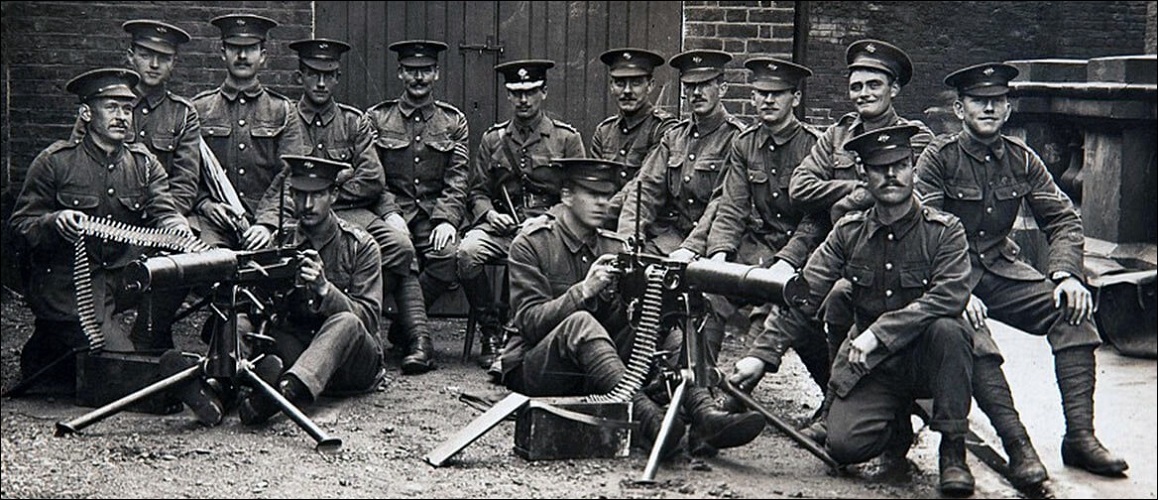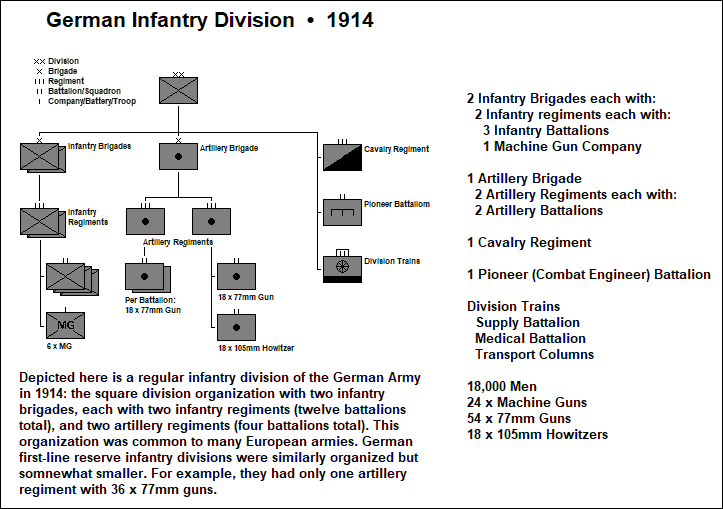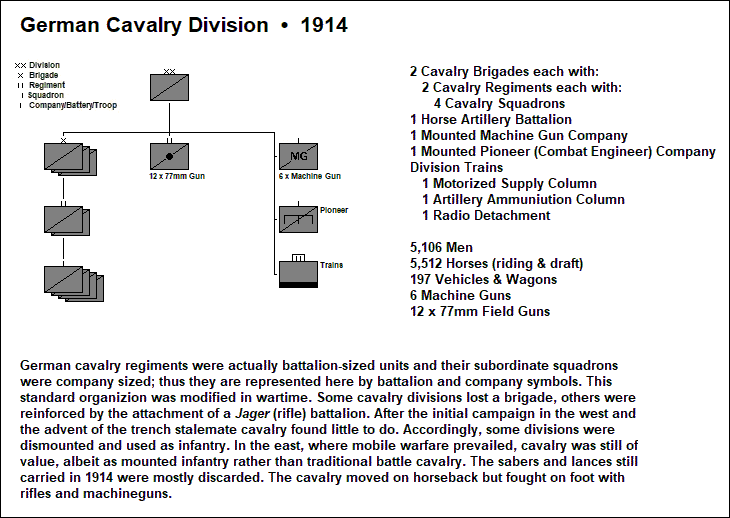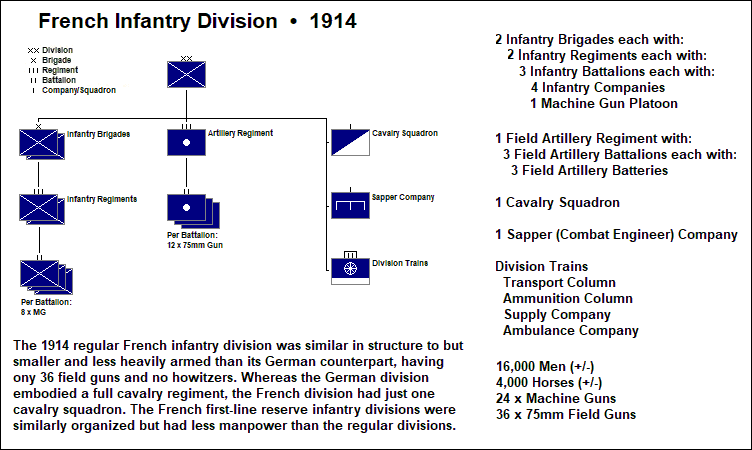● ● ●
At the
beginning of the Great War the armies of the major
belligerents were organized in roughly the same manner.
First came the numbered field armies, consisting of a
variable number of corps. The German Army in the west, for
example, was organized into seven field armies, each
controlling two to four corps depending on the tasks allotted
to them. The corps was the basic tactical formation; it
consisted of two or three infantry divisions plus various
corps troops. These latter usually included a medium
artillery regiment, a cavalry regiment, a pioneer (combat
engineer) battalion, and various supply columns. The total
strength of a corps was usually 70,000 to 80,000 men.
Cavalry corps were similar in structure but substantially smaller.
Except
for those of the British Army, infantry divisions were “square
divisions,” so called because they embodied two brigades,
each of two infantry regiments, each regiment with three or four
battalions. The infantry divisions of the British Army (which did not recognize the regiment as a tactical echelon
of command) were “triangular” with three brigades of four
battalions each. The division artillery usually consisted of
a brigade of two regiments with a total of eight to twelve
batteries with 36 to 56 field guns and howitzers. Divisions
also included a reconnaissance element—usually a horse
cavalry squadron—and the division trains (supply and
ammunition columns). By modern standards, the trains units
allotted to the division were scanty, such assets being
mostly concentrated at corps level. Though a few motor vehicles were
present, most transport was horse drawn. The total strength of
a 1914 infantry division was 16,000 to 20,000 men, depending
on nationality. Cavalry divisions had a similar organization
but a much lower strength: usually 8,000-10,000 men and 12
to 24 guns.
Field
armies and corps sometimes has aviation squadrons attached,
usually with six or eight airplanes, unarmed. Many commanders viewed these air units
with skepticism,
doubting their military value. But in the 1914 campaigns the
airplane proved its worth, operating much more effectively
than cavalry in the reconnaissance role . It was a French airplane, for
instance, that spotted and reported "Kluck's turn," the
redirection of the German Army's right wing that led
to the Battle of the Marne.
The
field armies of the belligerents embodied the divisions of
the active army plus the first-line reserve divisions. The
active divisions, consisting of long-service professional soldiers and
the current intake of conscripts, were maintained in
peacetime at two-thirds to full war strength. On
mobilization, they absorbed such recently trained reservists
as necessary to complete their organization. The reserve divisions, usually maintained in
peacetime
as cadres only, were brought up to war strength on
mobilization by absorbing the bulk of the most recently trained
reservists. In most cases the first-line reserve divisions
were slightly smaller than the active divisions, for example
with less artillery.
Older
reservists formed the second-line reserve units: territorial
or militia battalions and brigades for such duties as
protecting lines of communication, guarding prisoners,
garrisoning fortresses and the like. Usually they were armed
with older weapons that had been replaced in the field
army. In 1914, however, these second-line troops often found
themselves pressed into service as combat troops.
Only
the British Army deviated from this standard pattern. As a relatively
small all-volunteer force its reserve, consisting of men
who’d completed their service and returned to civilian life, was only sufficient to bring
the home-based part of the Regular Army (six infantry
divisions, one cavalry division and two cavalry brigades) up to war strength, and
to replace initial losses. The Territorial Force, somewhat
analogous to the US National Guard, was a part-time
volunteer organization whose members bore no obligation for
foreign service, though when war came the great majority did volunteer to
serve abroad. In 1914 many units of the Regular Army serving
in the colonies were brought back to Britain, being replaced
by Territorials.
The
uniforms of the soldiers of 1914 present a varied picture.
The British, the Russians and the Germans had already
replaced the brightly colored uniforms of past times with
khaki (for the first two) and gray-green (for the Germans)
field uniforms. The Austro-Hungarian Army had done likewise,
though its new blue-gray field uniform had been adopted with
an eye to war on the mountainous frontier with Italy and
proved rather too conspicuous for the Eastern Front. Only
the French Army went to war in its traditional, highly
visible colored uniforms— dark blue coats and madder-red trousers
for the infantry of the line—not the
least costly of the many mistakes it made in 1914. No army
provided its soldiers with steel helmets.
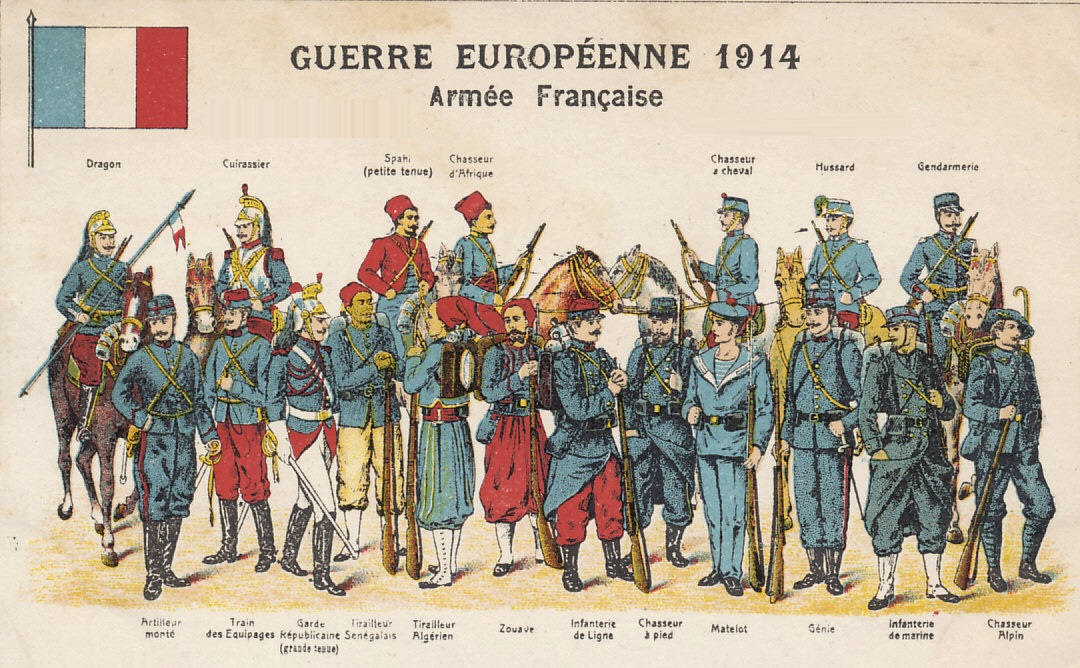
Contemporary collector's card showing the
uniforms of the French Army and Navy in 1914
The
weapons in the hands of the soldiers of 1914 were few and
basic by modern standards: the pistol, the rifle and bayonet, the machine gun
and, for cavalry, the saber and lance. Machine guns were
usually grouped in regimental machine gun companies (6-8
weapons), or battalion machine gun sections or platoons (2-4 weapons). Division artillery
consisted mostly of light field guns with a caliber of 75mm
to 80mm. Only the German and British divisions possessed
significant numbers of modern light field howitzers capable
of high-trajectory fire. Medium and heavy field artillery,
such as it was, was controlled by the corps and armies, the
Germans being somewhat better off than the others in this
category of weaponry. In 1914 large numbers of heavy guns
and howitzers permanently installed in fortresses were
hurriedly dismounted and pressed into field service when the
importance of heavy field artillery was realized.
Though
such weapons were under development in the years leading up
to 1914, no army as yet possessed the submachine guns, light
machine guns, mortars, grenade launchers, etc. that would be
in widespread use by 1918. Even so the firepower of an
infantry battalion armed with magazine rifles was many times
greater than that of its 1815 ancestor. Supplemented by
machine guns and supported by artillery, a 1914 infantry
battalion in defensive positions was capable of stopping an
attacking force many times its own size. Only the German
Army, however, had thought to equip its infantry with
entrenching tools.
But
the implications of this great increase in firepower were
not fully understood. Most armies championed the tactical
offensive, holding that a rapid, audacious attack could
overcome any defense. Hence the emphasis, for example in the
French Army, on the importance of high morale, an aggressive
spirit and the bayonet. Small-unit tactics received little
attention, professional soldiers believing that mass armies
comprised of civilians in uniform would be incapable of
executing complicated maneuvers under fire. Here again the
British Army was exceptional, consisting as it did of
well-trained professionals, many with considerable
experience of colonial war.
Such
were the armies that marched in August 1914—confident for
the most part that the war would be over by Christmas.
